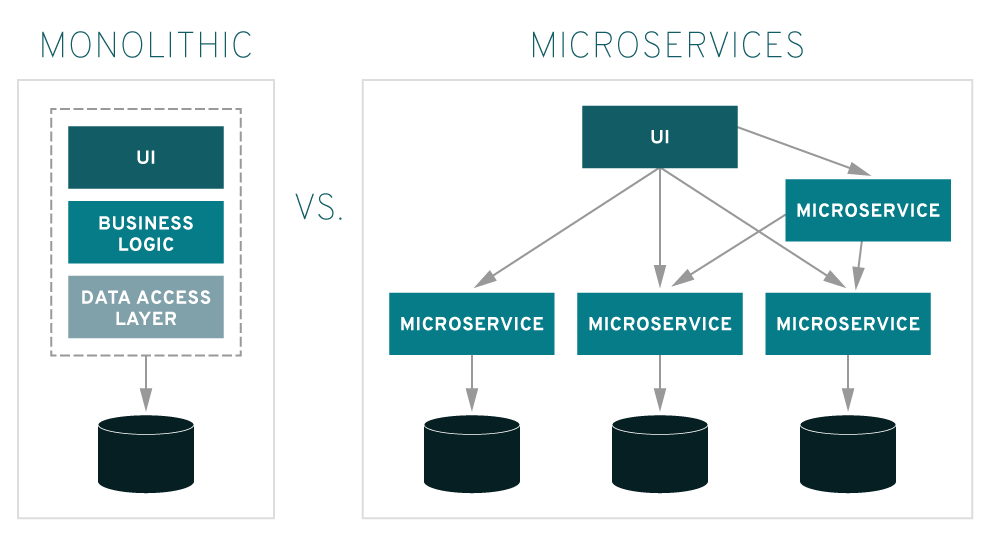Microservices or microservice architecture is most articulated in the current business environment. Microservice capacities in technology implementation has changed the overall pattern of how applications are developed and deployed. This ability brings more dynamism in fostering business agility at reduced business costs, which is why it is viewed as a facet of business strategy rather than a mere technology.
Evolution of Microservices From Monolithic Systems
Prior to Microservice architecture, monolithic architecture was used. The monolithic approach takes building the entire application as one single module. In this model, applications consist of three functional entity databases, client-side, UI (HTML pages or JS executed in a browser), and a server-side application. The client-side UI business logic is executed by the server-side application.
The problem with this architecture is these are “build all functionality at once and deploy it,” meaning that making changes to the application after deploying requires the same effort needed to build and deploy on the server side. Thereby resulting in a lack of agility, no code-reusability, and additional costs to scale up the business systems/applications.
Figure: Difference between Monolithic and Microservices
In this dynamic and mobility demanding business environments, overcoming the problems of rigidity and agility is one of the prime reasons that resulted in evolution of Microservices or Microservice architecture.
Understanding How Microservices Architecture Works
Prior to moving inside, let’s be clear; microservices and Service Oriented Architecture (SOA) are different, even though they appear similar in some features. In a microservice architecture, all these microservices are created around business capabilities and integrated as on demand. These are integrated by APIs. Microservices communication is stateless, meaning they can be scaled effortlessly and can avoid dependency on Enterprise Service Bus (ESB).
These services communicate through messages or interfaces. The specific reason why these microservices are modularized into services instead of library calls is: libraries are declared within software programs and calls to these libraries are in-memory. Making changes to these requires redeploying every time. Whereas, in the case of microservices, services out of process components communicate through RPCs.
Figure: Model view of microservice architecture
Microservices follow a modular based approach, where a business application is not built as a single unit. Instead, a larger business application is broken into small modules based on functions and each function is treated as a service, which is aimed at a business capability.
Each service is responsible for its own data management and will have a separate code base. Like any other application, it is developed, tested and deployed. Developers are free to choose a programming language to develop each service.
If any change is require for any of the services, developers can inculcate changes only to that service then build and deploy services independently, without having to put efforts in rebuilding and redeploying the entire business application. This way, microservice architecture promotes transparency, agility, code-reusability, and requires no extra outlays to scale up the business systems/applications.
Microservice as a Key Promoter of As-a-Service Economy
As large business capabilities are modularized into small unit business capabilities or services, these smaller unit services serve as valuable resources that can be reused for achieving different business functionalities, without having to develop the whole thing. Thereby saving a lot of development costs and time and decreasing time-to-market. As the communication between the services is regulated by APIs, clients are devoid of any impact (like downtime) on the service delivery, while adopting new changes to the functionality. This way, microservices can promote transparent and improved service delivery experiences and relationships between clients, consumers, stakeholders, and enterprises.
Continuous Integration and Microservices
Continuous Integration (CI) is the process of automating the build and testing of code every time a team member commits changes to version control"
Sam Guckenheimer, Product Owner, Visual Studio Team Services
Continuous integration is much discussed in this dynamic business environment. The simple reason is that in any project, numerous developers contribute code base and use diverse environments for executing their code. In this process, developers face various challenges. So, it is important to try the build in an unbiased, robust and standard environment. Here is what continuous integration does. On instant basis, the code developed is integrated and built on a centralized server continuously throughout the development life cycle. The purpose is to ensure if anything fails, it will fail sooner and be easy to catch. This way, developers can identify any code breakages immediately and fix it to ensure a stable build.
The micro-service architectures and cloud deployments demand development of robust reusable code base, where several teams of developers develop codes to autonomous portions of an overall product. Here, it is important to understand that without an automated system, one person alone can’t coordinate and run integration builds. This is where continuous integration comes in and is one of the prime forces to scale up the agile capabilities of microservices. Also, the microservices architecture modular approach played a major role in showing the importance of continuous integration significance in enterprises.
Conclusion
Microservice architecture capacities aren’t just limited to technology implementation, rather it is a business strategy. As a matter of fact, microservices capacities is one of the leading forces in promoting digital transformation efforts.


















